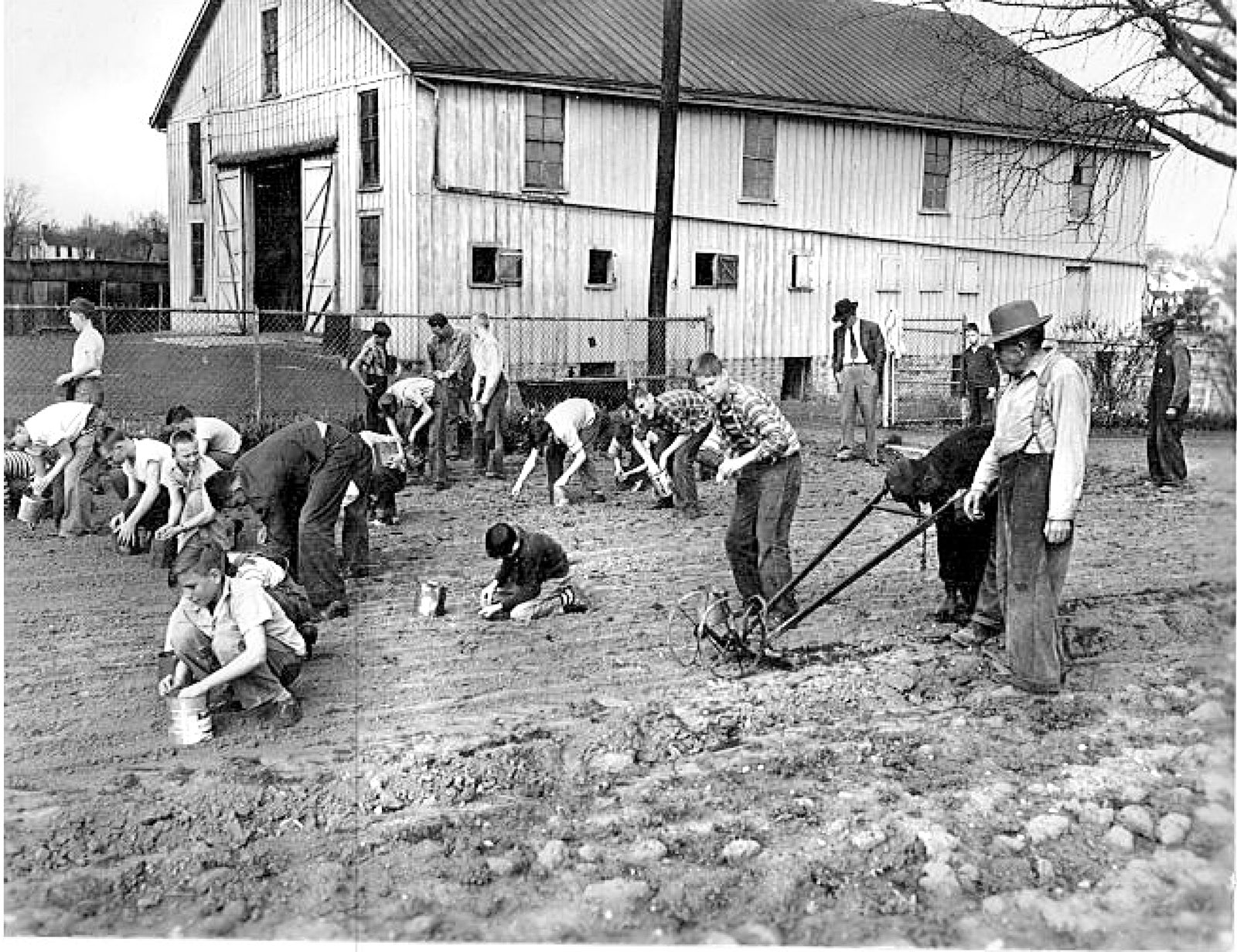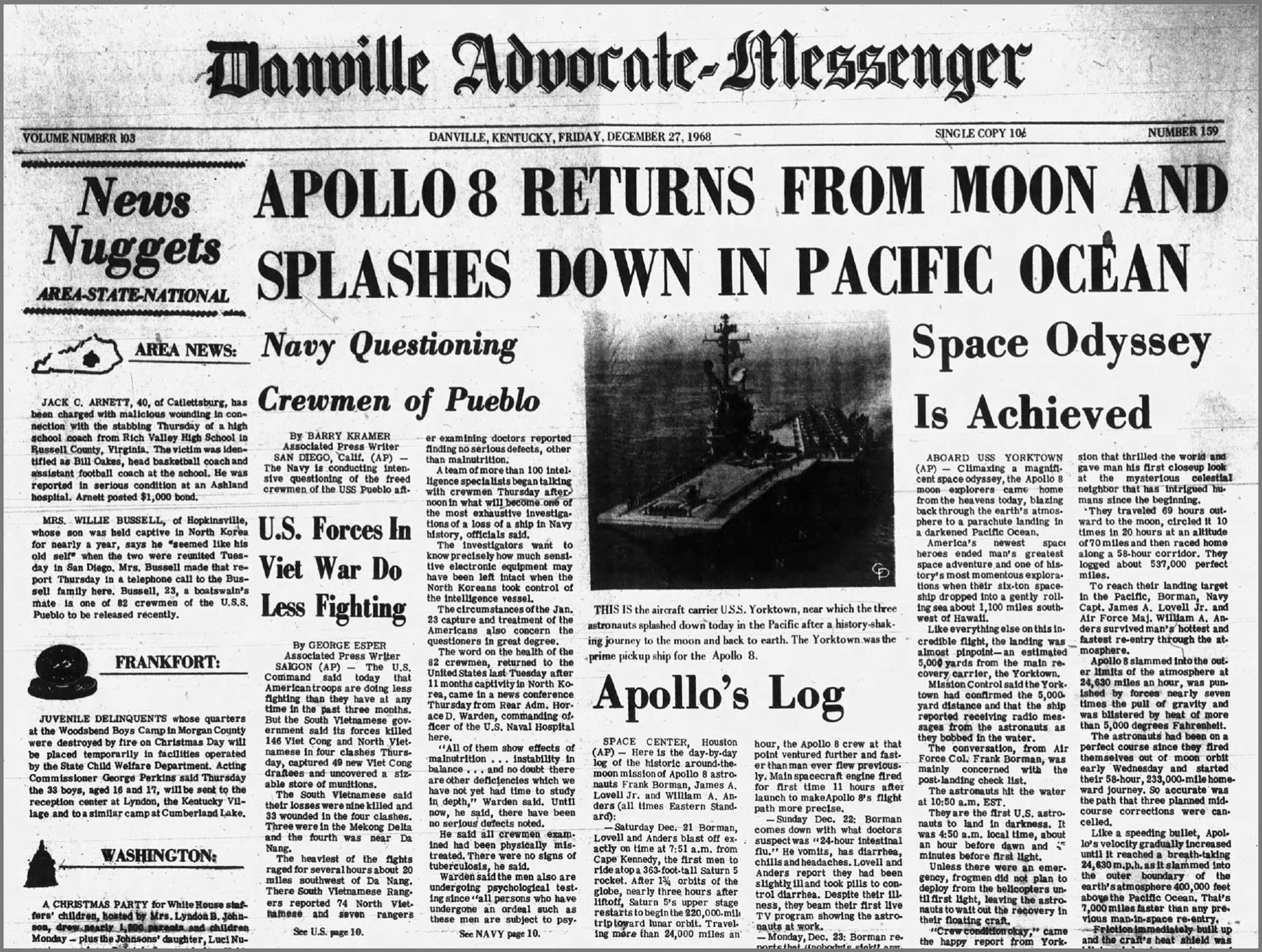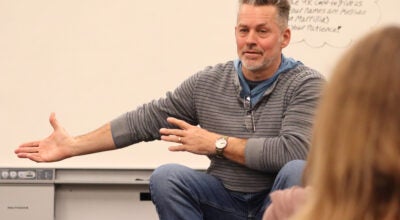Looking back at Kentucky School of the Deaf; part 2
Published 8:40 am Wednesday, April 5, 2017

- In the 1940s, KSD boys planted, weeded and harvested onions every year. Their work was supervised by Mr. Henry Lausman, the KSD gardener. This group of boys worked in the spring of 1948. The school’s goal was to produce as much food as possible on the campus grounds, making the enterprise as close to self-sufficient as possible.
Editor’s note: This column normally prints on Saturday’s Looking Back page, A 10, but space did not allow it in its entirety on April 1.
By JOANN HAMM and MARY FRAN MELTON
Jacobs Hall Museum
In 1874 Kentucky School for the Deaf began publishing a weekly in-house newspaper, the Kentucky Deaf-Mute, to give the male students an opportunity to learn the printing trade. KSD published the newspaper continuously from 1874 to 2004 with only a name change in 1896 – to the Kentucky Standard. From 1883 until 1942 George M. McClure was the editor of the paper. His relationships with students and wide connections with schools for the deaf throughout the country give a glimpse of the life students and staff had in a residential deaf school and show how the community touched the lives of students and staff at the school.
March 1917
The three troops of Boy Scouts went on a hike to Dix River last Saturday morning, returning late in the afternoon. They went by different routes, and the round trip distance covered was from 10 to 13 miles. This was the first hike of the season and the troops were out of practice, consequently a number were stiff and sore next day, but all thoroughly enjoyed the outing and are eager for another. Troop Seven, composed of the younger boys, distinguished themselves by making the trip in a quick time and with less evidence of fatigue than the two troops of older boys.
A few days ago one of the teachers gave her class a little straight talk about dawdling over work, and expressed her opinion of the pupil who takes 10 minutes to accomplish a task that should be completed in five. She warned them of the result of the habit of “soldiering” when the time comes for them to make their way in the world. One of the boys, Harry Smith, was so impressed with the talk that going from the school room to the shop, he set a new record on the turning lathe, turning 25 chair rungs in two hours. The instructor complimented Harry by telling him that he could not turn as many in the same time himself. Next morning Harry told his teacher of the performance with a good deal of pride and she had to confess that his chances of holding a job after finishing school were gilt-edge if he can keep up the pace set.
A great many of our pupils have relatives in the United States Army and Navy. The other day while George Whitenack was looking through a copy of Leslie’s Weekly, he came across a picture of his brother, Elwood Whitenack, among a group of naval cadets in training at Lake Bluff, Illinois. It was a pleasant surprise for George.
The girls have been very excited over the railroad strike. I think they are afraid they can’t go home in June.
Last Friday morning we, the members of the Camp Fire Girls, addressed invitations to our friends, the Boy Scouts, and some others, inviting them to attend our party in honor of St. Patrick’s birthday. We had a splendid party. As the crowd could not all meet in one room, part of us met in the Girls’ Study Hall and the others in the parlor. The Girls’ Study Hall was beautifully decorated with green crepe paper and the parlor was also appropriately decorated.
— “From the Girls’ Side”, Martha Moore, Reporter
Saturday evening at 7:30 o’clock the Camp Fire Girls, dressed in white, assembled for the party. Each girl wore a shamrock. The girls went to the parlor where they waited for their escorts to come for them. Pairing off, we went into the Girls’ Study Hall and were received by the guardians and a number of the teachers. Soon after we were seated, Mr. Rogers came in. Miss Joiner asked him to suggest some games to play and he told her to play “Forfeits”. Miss Kennedy and Mrs. Marcosson had charge of the game, and we had many good laughs at the “stunts” the boys and girls had to perform to redeem their “Forfeits”. After playing “Forfeits” awhile we began to play “Wink,” “Animals,” “Spinning the Plate” and other games.
Mrs. Welch’s class and Miss Bell’s class went up town last Thursday. They went to the post office first. Mr. Wood invited them to come into his office. They saw many letters, cards and boxes for people in Danville. Then they went to Welsh and Wiseman’s store. They rode in the elevator. Mr. Wiseman gavwe a post card to each boy and girl.
Our household was shocked Friday evening to learn of the sudden death of little Catherine Harris Giovannoli, only daughter of Mr. Harry Giovannoli, editor of the Lexington Leader, and niece of Miss Olive Giovannoli of our school. The little one recently had an attack of scarlet fever but was supposed to have entirely recovered: but a sudden attack of laryngitis brought death in a few hours. Little Catherine had made her home here with her Aunt since the death of her mother about two years ago. She was a singularly sweet and attractive child, sunny tempered and affectionate, a favorite with everyone at the school. She and the little girls at the cottage were fast friends, and there was grief among them when they learned that their playmate was dead. The funeral was held Sunday afternoon at the residence of Dr. J. H. Letcher, on Lexington Avenue, the services being conducted by Dr. E. M. Green of the First Presbyterian Church. A profusion of lovely flowers surrounded the little coffin, and there were many there to mourn with the stricken father, brothers and other relatives when it was carried to the Danville cemetery and placed beside her mother.
Mr. Blount has started out to reduce the high cost of living by taking up the raising of squabs for market. Some of the carpenter boys have made a convenient and serviceable pigeon loft, and he has secured a stock of young pigeons from Mr. Suttka, who has been in the business for several years. With Mr. Suttka to assist him with suggestions at the outset, he expects to make a success of the venture. Mr. Suttka usually has four or five hundred pairs of pigeons on hand, and he ships many squabs to the Pittsburgh market where they find ready sale at high prices. He claims that pigeons pay a much better profit than chickens.
March 1942
A history of our colored school
On May 9, 1884, a school for the colored deaf children of Kentucky was established at Danville under the same board and superintendent of the white school of the Kentucky School for the Deaf by an act of the State Legislature. A sum of five thousand dollars was given for buildings and an annual appropriation of $2,500 was also made for salaries of teachers and officers.
The school purchased the Tompkins property, a short distance south on Second Street, and became the owner of a large two- story brick house. Plans were made to use it as a colored school. But an opportunity came when our school had a chance to secure the old Grigsby homestead just across Second Street from the white deaf school. It was bought for $5,000 cash plus the Tompkins house with three acres of land. The Grigsby place contained grounds, garden and pasture, and a large colonial mansion, two stories high, 42 by 46 feet including the large front porch with its ionic columns, and with two wings of one story each, 45 by 22 ft. at the ends ; in the rear was an ell of one story 55 by 22 ft. The building was built by Joseph Weisiger in about 1845 and it was named “Warwick,” and became the family residence of himself, of Dr. E. P. Humphery, and of Colonel J. Warren Grigsby.
Messrs. David Dudley and William K. Argo were superintendents at the time when the school was opened. Mr. Morris T. Long was the first teacher and supervisor. Mrs. Nannie R. Long was the first matron of the school. The school started on February 2nd, 1885 with eight pupils. In 1887 there were fifty pupils with four teachers. Now it has twenty-four pupils with two teachers. A little more than 250 colored deaf girls and boys have entered this school.—The News.
Our school’s defense activities
The members of our household, officers and pupils alike, as well as the adult deaf of Danville, are co-operating heartily with the agencies and officials, state and national, charged-with directing defense activities. To inculcate patriotism and reverence for the flag, the Stars and Stripes is displayed in every school room, in every shop, hall and recreation room on the place with the “Pledge to the Flag” under it.
Everybody in the place has started collecting and turning in the essential materials asked for by the government in order to help win the war. Our people are buying defense bonds and stamps according to their means. Messrs. Lee, Beauchamp, and C. B. Grow have organized First Aid Classes under the sponsorship of the Civilian Defense Council, which meet in our new school building twice a week for instruction. Mr. Beauchamp is training the adult deaf of Danville, while Mr. Lee has two classes made up of people from town, one meeting Mondays and Wednesdays and the other Tuesdays and Thursdays. Mr. Grow has general oversight of this work in Boyle County for both white and colored people. All persons who registered for service in the civilian defense program are to be given a course in first aid before being assigned to their other posts.
There are very few people in Boyle County competent to give this first aid course, but Messrs. Lee, Grow and Beauchamp took training in it a couple of years ago and had classes in it last year for our older students. This school aims to cooperate 100 percent with the state and national governments in their efforts to win the war.
Trouble shooter
Mr. Chas. A. Thomas, instructor in printing at this school, has come to be looked upon as “trouble shooter” by many newspaper owners in this section when linotypes get out of order. He has the knack for locating the seat of trouble and the ability to correct it in short order. The latest call for his services came from Harrodsburg this week where he put a balky machine in order. He trains the apprentices in The Standard office to take our linotypes apart and put them together again. As a linotype has several thousand separate parts, this is some feat.
Danville’s deaf citizens
Danville has 63 deaf residents besides the 375 students who spend the school year in this city. Fifty-eight are white and five are colored. Six are teachers in the academic department of the School for the Deaf and six in the vocational department; six are supervisors, and there are coaches, cooks, janitors, laundry employees, etc. Among those employed in town are two printers, six carpenters, three factory workers, and several housekeepers. A number are married and have nice bright children. Several own their own homes. The group is an intelligent, well-educated one, proving the truth of what President Garfield once said — that it Is “an act of enlightened selfishness on the part of the State” to found and support schools for the deaf.
Save paper
One of the articles that the American people are asked to conserve is paper, for a shortage in this essential material is threatened… A great deal of paper is used in a big school such as this, and with a little care it is possible to collect many pounds that would ordinarily go to waste. Buck Qualls and Ben Williams have made a serviceable paper baler in the carpenter shop, and Superintendent Lee has appointed Mr. Chas. A. Thomas to have charge of collecting waste paper. He will be assisted by Miss Clyde Reynolds at the colored school; Mrs. J. C. Ewing in the older girls’ building; Mr. Alfred E. Marshall in the older boys’ building; Ray Chesnut, cottage buildings; Robin Chesnut, main buildings. Ulysses Burdett will collect the paper and deliver it at the shop building where the printer boys will do the baling.
Paper of every kind from old newspapers, cardboard, boxes, magazines up to the finer grades is desired. Don’t burn any paper. Turn it over to the salvage squad.





